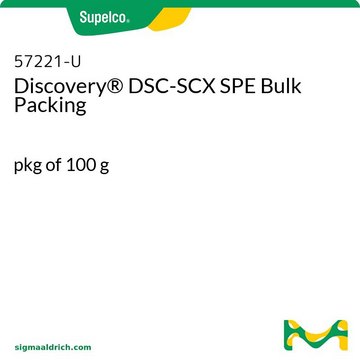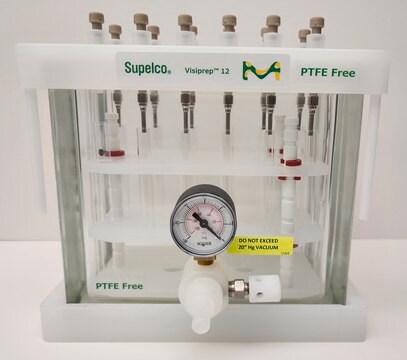57228-U
Phase pour SPE en vrac Discovery® DSC-WCX SPE
pkg of 100 g
Synonyme(s) :
Discovery® DSC-WCX
About This Item
Produits recommandés
Conditionnement
pkg of 100 g
Technique(s)
solid phase extraction (SPE): suitable
Groupe de la matrice active
carboxypropyl bonding
Application(s)
food and beverages
Technique de séparation
ion exchange
Catégories apparentées
Description générale
Sample Matrix Compatibility: Organic or aqueous solutions
- A polymerically bonded, ethylenediamine triacetic acid phase with a pKa of 4.8
- Counter ion is Na+
- Ion exchange capacity is ∼ 0.15 meq/g
- Carries a negative charge at pH 6.8 or above
- A pH of 2.8 or below neutralizes this phase for easier elution of strong cationic analytes that are neutralized only at extreme basic conditions
- Typically used when dealing with very strong cationic (high pKa) compounds that may be irreversibly retained on strong cation exchangers
Informations légales
Mention d'avertissement
Danger
Mentions de danger
Conseils de prudence
Classification des risques
Eye Dam. 1 - Skin Sens. 1
Code de la classe de stockage
11 - Combustible Solids
Classe de danger pour l'eau (WGK)
WGK 3
Point d'éclair (°F)
Not applicable
Point d'éclair (°C)
Not applicable
Faites votre choix parmi les versions les plus récentes :
Déjà en possession de ce produit ?
Retrouvez la documentation relative aux produits que vous avez récemment achetés dans la Bibliothèque de documents.
Articles
SPE retention mechanism in this case is based on the electrostatic attraction of charged functional groups of the analyte(s) to oppositely charged functional groups on the sorbent.
Protocoles
Retention occurs through polar interaction between the sorbent and analytes. Typical sample matrices that can be employed in normal-phase SPE include hydrocarbon or fatty oils diluted in a solvent like hexane, isooctane, chlorinated solvent, THF, diethyl ether, or ethyl acetate.
Notre équipe de scientifiques dispose d'une expérience dans tous les secteurs de la recherche, notamment en sciences de la vie, science des matériaux, synthèse chimique, chromatographie, analyse et dans de nombreux autres domaines..
Contacter notre Service technique









